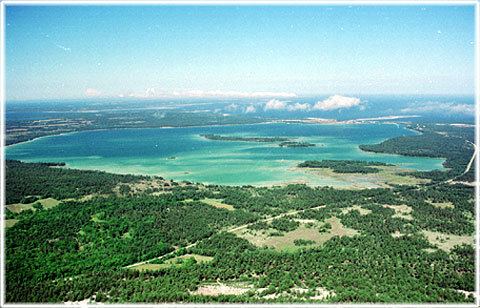Catchment area 39.92 km (15.41 sq mi) Surface elevation 6.1 m Mean depth 4.5 m | Type freshwater lake Basin countries Sweden Area 6.3 km² Shore length 14.8 km | |
 | ||
Primary inflows Primary outflows a culvert in the north, previously for electricity production | ||
Lake Bästeträsk is a freshwater lake located in the northern part of the Swedish island of Gotland. It is the largest lake on the island.
Contents
Map of Lake B%C3%A4stetr%C3%A4sk, 624 60 L%C3%A4rbro, Sweden
Geography
The lake is located at the north end of Gotland only 0.4 km (0.25 mi) from the Baltic Sea. It has three islands: Falholmen, Storholmen and Lillholmen. The lake represents 681 ha (1,680 acres) of the 1,494 ha (3,690 acres) Bästeträsk nature reserve, one of the largest on Gotland. With an area of 6.52 km2 (2.52 sq mi) it is the largest lake on the island. Despite its size, the maximum depth is only 4.5 m (15 ft) and most of it is considerably shallower.
Geology
Most of the lake is surrounded by a so called "beach barricade", a 0.5 to 1 m (1.6 to 3.3 ft) high wall of gravel and larger blocks of stone, that has been displaced or pushed out by the expanding ice during the winter.
The bottom of the lake is made up of blocks of stone, especially in the shallower parts, and sediments.
It is connected to the Baltic Sea through the stream Arån, which is a breeding ground for sea trout.
Biology
Bästeträsk is a freshwater reserve with very clean inflows, a number of them has the same aspects as drinking water. The water has a greenish tint with low content of nutrients, making the lake almost void of vegetation save for stands of Chara aspera, Chara tomentosa, Chara globularis and the only occurrence in Sweden of Nitella tenuissima. It inhabits species such as northern pike, perch, roach, rudd, tench, european bullhead and whitefish. The lake was stocked with crayfish during the 1920s. A number of rare lichens and polyporales can be found in the nature reserve surrounding the lake, along with the Cochlicopa nitens land snail. The islands in the lake have a large colony of eiders.
Uses
The area around Bästeträsk has been used for quarrying limestone since the 1650s. The production ceased in 1990, but traces of the industry remain. Most visible are the two smaller quarry lakes north of the lake. The northwest of these lakes, "The Blue Lagoon", is a well visited swimming site.
The lake's outflow in the north was dammed up and led through a culvert for production of hydroelectricity following a decision in 1939. As of 2015 only the culvert remains. In winter the lake is sometimes used for tour skating.
